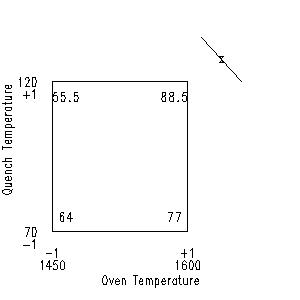5.5. Advanced topics
5.5.9. An EDA approach to experimental design
5.5.9.10. DOE contour plot
5.5.9.10.7. |
How to Interpret: Optimal Setting |
Theoretically, any (X1, X3) setting along the optimal curve would generate the desired response of Y = 100. In practice, however, this is true only if our estimated contour surface is identical to "nature's" response surface. In reality, the plotted contour curves are truth estimates based on the available (and "noisy") n = 8 data values. We are confident of the contour curves in the vicinity of the data points (the four corner points on the chart), but as we move away from the corner points, our confidence in the contour curves decreases. Thus the point on the Y = 100 optimal response curve that is "most likely" to be valid is the one that is closest to a corner point. Our objective then is to locate that "near-point".
Having done so, it is of interest to note the coordinates of that optimal setting. In this case, from the graph, that setting is (in coded units) approximately at
-
(X1 = 1.5, X3 = 1.3)
To deduce his, we need to refer back to the original (uncoded) factors in this problem. They were:
|
Coded Factor |
Uncoded Factor |
|---|---|
| X1 | OT: Oven Temperature |
| X2 | CC: Carbon Concentration |
| X3 | QT: Quench Temperature |
- Oven Temperature (1450 and 1600 degrees)
- Carbon Concentration (0.5 % and 0.7 %)
- Quench Temperature (70 and 120 degrees)
- X1 (-1, +1)
- X2 (-1, +1)
- X3 (-1, +1)

The "X" on the chart represents the "near point" setting on the optimal curve.
-
OT = 1450 => X1 = -1
OT = 1600 => X1 = +1
-
X1 = 0 being at OT = (1450 + 1600) / 2 = 1525
|-------------|-------------|
X1: -1 0 +1
OT: 1450 1525 1600
and so X1 = +2, say, would be at oven temperature OT = 1675:
|-------------|-------------|-------------|
X1: -1 0 +1 +2
OT: 1450 1525 1600 1675
and hence the optimal X1 setting of 1.5 must be at
-
OT = 1600 + 0.5*(1675-1600) = 1637.5
-
QT = 70 => X3 = -1
QT = 120 => X3 = +1
-
X3 = 0 being at QT = (70 + 120) / 2 = 95
|-------------|-------------|
X3: -1 0 +1
QT: 70 95 120
and so X3 = +2, say, would be quench temperature = 145:
|-------------|-------------|-------------|
X3: -1 0 +1 +2
QT: 70 95 120 145
Hence, the optimal X3 setting of 1.3 must be at
-
QT = 120 + 0.3*(145-120)
QT = 127.5
-
coded : (X1 = +1.5, X3 = +1.3)
uncoded: (OT = 1637.5 degrees, QT = 127.5 degrees)
-
coded : (X1 = +1.5, X2 = -1.0, X3 = +1.3)
uncoded: (OT = 1637.5, CC = 0.7 %, QT = 127.5)
- collect a single data point (if money and time are an issue) at
this recommended setting and see how close to 100 % we achieve, or
- collect two, or preferably three, (if money and time are less of
an issue) replicates at the center point (recommended setting).
- if money and time are not an issue, run a 22 full factorial design with center point. The design is centered on the optimal setting (X1 = +1, 5, X3 = +1.3) with one overlapping new corner point at (X1 = +1, X3 = +1) and with new corner points at (X1, X3) = (+1, +1), (+2, +1), (+1, +1.6), (+2, +1.6). Of these four new corner points, the point (+1, +1) has the advantage that it overlaps with a corner point of the original design.

